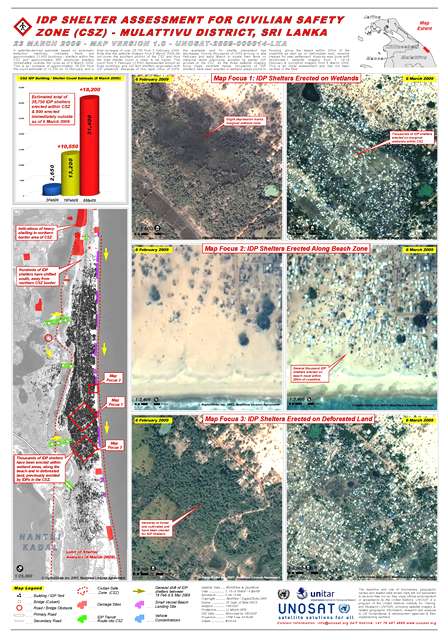New UN Report on Sri Lanka Conflict Includes UNOSAT Analysis
17 September 2015, Geneva, Switzerland - A report issued by the UN Office of the High Commissioner for Human Rights on 16 September concludes that patterns of grave violations in Sri Lanka between 2002 and 2011 indicate that war crimes and crimes against humanity were most likely committed by both sides to the conflict. The report also recommends the establishment of a hybrid special court to bring justice. High Commissioner Zeid said: “Importantly, the report reveals violations that are among the most serious crimes of concern to the international community as a whole.” “This report is being presented in a new political context in Sri Lanka, which offers grounds for hope,” he said.
The report covers years of conflict during which a number of violations were committed by both sides. The report is divided into two parts which are interlinked: 1) The overarching Report of the Office of the United Nations High Commissioner for Human Rights on Promoting Reconciliation, Accountability and Human Rights (A/HRC/30/61) (Microsoft Word document); and the accompanying report of the OHCHR Investigation on Sri Lanka (A/HRC/30/CRP.2) which can be found here: http://www.ohchr.org/EN/HRBodies/HRC/RegularSessions/Session30/Documents/A_HRC_30_CRP_2.doc
The investigation was supported also by UNOSAT expert analysis, which was used by the UN investigation team to supplement or complement their findings and witnesses’ accounts, noting that the investigation team was not granted access to Sri Lanka. At the time of the conflict UNOSAT had been called by humanitarian agencies to provide analysis on the situation of thousands of IDPs and civilians being affected by the fighting’s and in need of urgent humanitarian assistance.
The UNHCHR main report mentions that “UNOSAT provided invaluable analysis on satellite imagery”, while the investigation report references UNOSAT analysis 15 times in its text. “This is a turning point in the use of this technology in UN inquiries mandated by member states” says UNITAR Research Director Francesco Pisano. “It is also an example of how our expertise can help protect and apply international humanitarian law”.
The UN Human Rights Office (OHCHR) was mandated by the UN Human Rights Council last year to conduct a comprehensive investigation into alleged serious violations and abuses of human rights and related crimes by both parties in Sri Lanka during the period 2002-11. The analysis by the UNOSAT team was used extensively during the investigation, marking a distinct progress in the use of satellite imagery analysis by commissions of inquiry appointed by UN member states. In recent years UNOSAT has been called to collaborate with several panels of experts and special independent commissions of inquiry including in Libya, Syria, and Sri Lanka. UNITAR and UNOHCHR have signed an agreement in 2015 to expand this important collaboration. In addition UNOSAT works also with the International Criminal Court, which uses satellite imagery analysis by the team in some of its proceedings.
“At the time of the final stages of the conflict in Sri Lanka, we used satellite imagery to inform our humanitarian colleagues about the areas with worst humanitarian impact, says Einar Bjorgo, Manager of UNOSAT. Years later some of those analyses are still valuable and provided objective information for the investigation”.
Related link
UNOSAT maps on Sri Lanka

